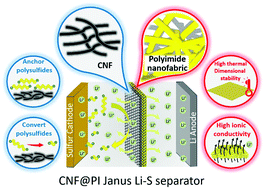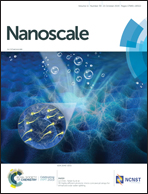A Janus nanofiber-based separator for trapping polysulfides and facilitating ion-transport in lithium–sulfur batteries
Abstract
Endowing separators with the polysulfide-blocking function is urgently needed for high-performance lithium–sulfur (Li–S) batteries. Thus far, most of the reported research has focused on modifying conventional polyolefin separators but with poor thermal stability and low ionic conductivity. To address these issues, herein we report a Janus separator based on a thermally stable polymeric nanofabric designed with abilities to trap polysulfides and facilitate the transport of Li+ simultaneously. This Janus separator possesses a configuration of a carbon nanofiber (CNF) layer toward the sulfur cathode and the polyimide (PI) nanofabric toward the Li metal anode. It is demonstrated that the conductive CNF layer can effectively anchor and convert the polysulfides; meanwhile, the excellent wettability with liquid electrolytes and the highly porous structure of the PI nanofiber layer significantly promote the Li+-transport. In addition, the Janus separator presents notable advantages in thermal dimensional stability benefiting from the PI nanofabric. As a result, the Li–S battery armed with the Janus separator shows a high initial capacity (1393 mA h g−1 at 0.1 A g−1), stable cycling performance (822 mA h g−1 at 1 A g−1) and high coulombic efficiency of 99.6%.



 Please wait while we load your content...
Please wait while we load your content...